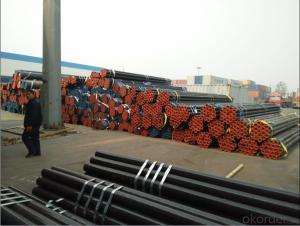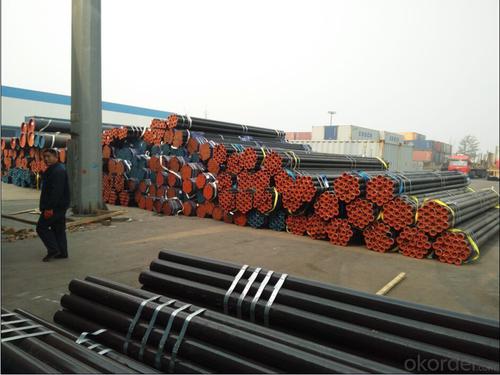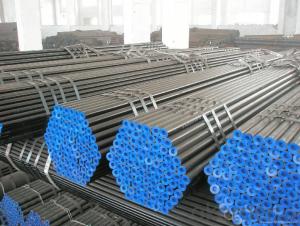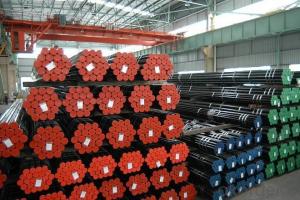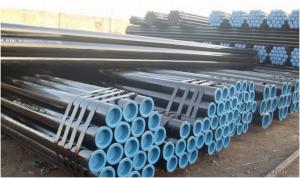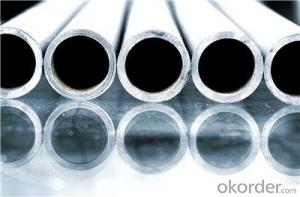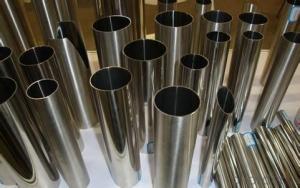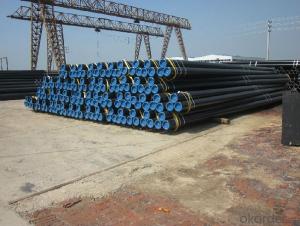Carbon Steel Seamless Steel Pipe API 5L, ASTM A 53, High Quality
- Loading Port:
- Tianjin
- Payment Terms:
- TT OR LC
- Min Order Qty:
- 25 m.t.
- Supply Capability:
- 10000 m.t./month
OKorder Service Pledge
OKorder Financial Service
You Might Also Like
1、Structure of Carbon Steel Seamless Steel Pipe API 5L, ASTM A 53, High Quality:
Seamless pipe is formed by drawing a solid billet over a piercing rod to create the hollow shell. As the manufacturing process does not include any welding, seamless pipes are perceived to be stronger and more reliable. Historically seamless pipe was regarded as withstanding pressure better than other types, and was often more easily available than welded pipe.
2、Main Features of the Carbon Steel Seamless Steel Pipe API 5L, ASTM A 53, High Quality:
• High manufacturing accuracy
• High strength
• Small inertia resistance
• Strong heat dissipation ability
• Good visual effect
• Reasonable price
3、Carbon Steel Seamless Steel Pipe API 5L, ASTM A 53, High Quality Specification:
Standard | GB, DIN, ASTM ASTM A106-2006, ASTM A53-2007 |
Grade | 10#-45#, 16Mn 10#, 20#, 45#, 16Mn |
Thickness | 8 - 33 mm |
Section Shape | Round |
Outer Diameter | 133 - 219 mm |
Place of Origin | Shandong, China (Mainland) |
Secondary Or Not | Non-secondary |
Application | Hydraulic Pipe |
Technique | Cold Drawn |
Certification | API |
Surface Treatment | factory state or painted black |
Special Pipe | API Pipe |
Alloy Or Not | Non-alloy |
Length | 5-12M |
Outer Diameter | 21.3-610mm |
Grade | 20#, 45#, Q345, API J55, API K55, API L80, API N80, API P110, A53B |
Standard | ASME, ASTM |
1) Material:20#(ASTM A 106/A53 GRB.API5LGRB,GB),45#,16Mn,10#.
2) Specification range:OD:21.3-610mm,WT:6-70mm,length:6-12m or according to the requirement of clients.
3) Excutive standards:GB,ASME API5L.ASTM A 106/A53,Despite of the above standards,we can also supply seamless steel pipe with standard of DIN,JIS,and so on,and also develop new products according to the requirements of our clients!
4) Surface:black lacquered,varnish coating or galvanized.
5) Ends:Beveled or square cut,plastic capped,painted.
6) Packing:bundles wrapped with strong steel strip,seaworthy packing.
4、Packaging & Delivery
Packaging Details: | seaworthy package,bundles wrapped with strong steel strip |
Delivery Detail: | 15-30days after received 30%TT |
5、FAQ of Carbon Steel Seamless Steel Pipe API 5L, ASTM A 53, High Quality:
①How is the quality of your products?
Our products are manufactured strictly according to national and internaional standard, and we take a test
on every pipe before delivered out. If you want see our quality certifications and all kinds of testing report, please just ask us for it.
Guaranteed: If products’ quality don’t accord to discription as we give or the promise before you place order, we promise 100% refund.
②How about price?
Yes, we are factory and be able to give you lowest price below market one, and we have a policy that “ for saving time and absolutely honest business attitude, we quote as lowest as possible for any customer, and discount can be given according to quantity”,if you like bargain and factory price is not low enough as you think, just don’t waste your time.Please trust the quotation we would give you, it is professional one.
③Why should you chose us?
Chose happens because of quality, then price, We can give you both.Additionally, we can also offer professional products inquiry, products knowledge train(for agents), smooth goods delivery, exellent customer solution proposals.Our service formula: good quality+good price+good service=customer’s trust
SGS test is available, customer inspection before shipping is welcome, third party inspection is no problem.
6、Carbon Steel Seamless Steel Pipe API 5L, ASTM A 53, High Quality Images:
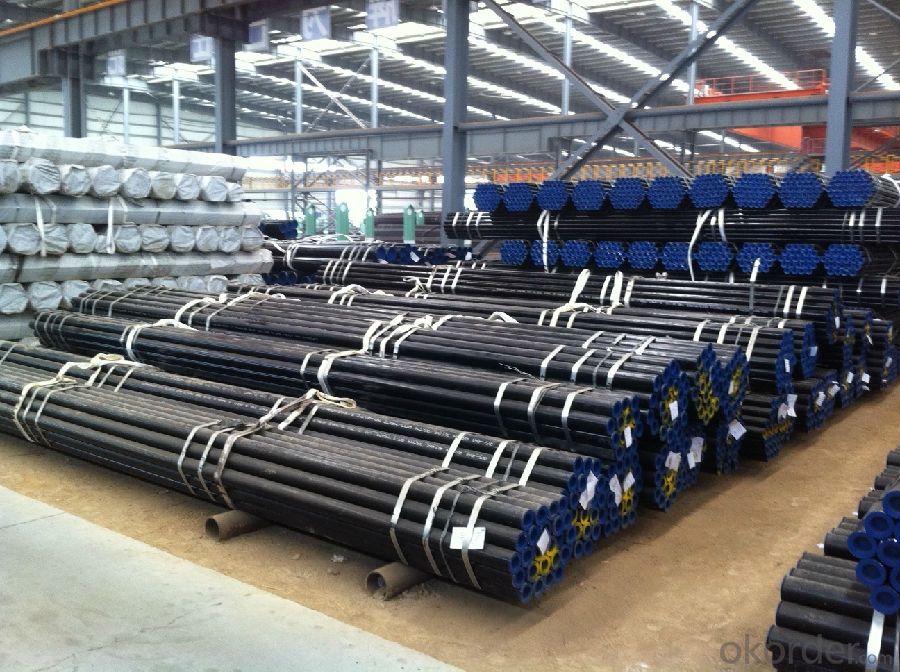
- Q: Can steel pipes be threaded?
- Yes, steel pipes can be threaded. Threading is a common process used to create a screw-like pattern on the outer surface of the pipe, allowing it to be connected to other fittings or components. Threading can be done manually or with the help of machinery, depending on the size and requirements of the pipe.
- Q: What is the outer diameter and wall thickness of the welded steel pipe of national standard DN250?
- DN (nominal diameter) 250 is generally the industry said 273, welded steel pipe (spiral steel pipe) thickness is generally between 6-8mm, more common.
- Q: How do steel pipes perform in corrosive environments?
- Steel pipes perform well in corrosive environments due to their high resistance to corrosion. They are commonly used in industries such as oil and gas, chemical processing, and wastewater treatment where exposure to corrosive substances is prevalent. The protective oxide layer on the surface of steel pipes prevents the material from getting corroded, ensuring long-term durability and reliability. Additionally, steel pipes can be further protected by coatings or linings to enhance their resistance to corrosion in highly aggressive environments.
- Q: Can steel pipes be used for underground sewer systems?
- Yes, steel pipes can be used for underground sewer systems. Steel pipes are strong, durable, and resistant to corrosion, making them suitable for underground applications. However, factors such as the type of soil, water composition, and potential for ground movement should be considered to ensure proper installation and longevity of the sewer system.
- Q: What is the elasticity of steel pipes?
- Steel pipes exhibit elasticity, which allows them to undergo deformation when external forces are applied and regain their original shape once the force is no longer present. The high elasticity of steel pipes is well-known, as it enables them to endure different types of stress and strain without suffering permanent deformation. This characteristic is vital in situations where pipes experience pressure, bending, or other mechanical forces. The elasticity of steel pipes is determined by material properties like its Young's modulus, which quantifies its stiffness and capacity to resist deformation.
- Q: How do you transport steel pipes safely?
- Transporting steel pipes safely requires proper planning, equipment, and adherence to safety measures. Here are some guidelines to ensure the safe transportation of steel pipes: 1. Choose appropriate transportation equipment: Use a flatbed trailer or a truck with a flatbed to transport steel pipes. Ensure that the trailer or truck has a strong and secure tie-down system to prevent the pipes from shifting during transit. 2. Secure the pipes: Use nylon or steel straps to secure the steel pipes to the trailer or truck bed. Make sure the straps are tightened properly, evenly distributing the weight of the pipes and preventing any movement or shifting. 3. Protect the pipes: Use pipe chocks or padding materials such as foam or rubber to prevent the pipes from rolling or rubbing against each other during transportation. This helps to minimize potential damage and maintain the integrity of the pipes. 4. Observe weight limits: Ensure that the weight of the steel pipes being transported does not exceed the load capacity of the transportation equipment. Overloading can lead to instability and compromise safety. 5. Follow road safety regulations: Adhere to all local traffic laws and regulations, including speed limits and securing all necessary permits or licenses for oversized loads if required. Additionally, use hazard warning signs or flags when transporting long or oversized steel pipes to alert other road users. 6. Conduct regular inspections: Before starting the journey, inspect the straps, tie-downs, and other securing mechanisms to ensure they are in good condition. Regularly check the load during transit to ensure it remains secure. 7. Plan the route: Choose a route that is suitable for the size and weight of the steel pipes being transported. Avoid roads with low bridges, narrow lanes, or weight restrictions that may pose a risk to the safe transportation of the pipes. 8. Consider weather conditions: Take into account weather conditions, such as strong winds or heavy rain, which can affect the stability of the load. Adjust the transport plan accordingly or delay the journey if necessary. 9. Train and educate drivers: Ensure that the drivers responsible for transporting steel pipes are well-trained and aware of the proper procedures for securing and transporting the load safely. Regularly update them on safety protocols and any changes in regulations. By following these guidelines, you can transport steel pipes safely, minimizing the risk of accidents, damage to the pipes, and ensuring the safety of everyone involved in the transportation process.
- Q: Are steel pipes suitable for use in sewage treatment plants?
- Yes, steel pipes are suitable for use in sewage treatment plants. Steel pipes are durable, corrosion-resistant, and have a long lifespan, making them ideal for handling the harsh conditions and corrosive substances found in sewage systems. Additionally, steel pipes offer high strength and are capable of withstanding high-pressure flows, making them a reliable choice for sewage treatment plants.
- Q: How are steel pipes used in the water supply system?
- Steel pipes are used in the water supply system to transport and distribute water efficiently and safely. They are durable, corrosion-resistant, and have a high carrying capacity, making them ideal for transporting large volumes of water over long distances. Steel pipes are commonly used for mains and transmission lines in water supply networks, ensuring a reliable and steady water flow to homes, businesses, and industries.
- Q: What are the common methods for inspecting the integrity of steel pipes?
- There are several common methods used to inspect the integrity of steel pipes. These methods are crucial to identify any defects or weaknesses in the pipes that could compromise their structural integrity and potentially lead to failures or leaks. 1. Visual Inspection: This is a basic method where an inspector visually examines the external surface of the steel pipe for any signs of damage, such as corrosion, cracks, or deformities. It is a quick and cost-effective method, but it may not detect internal defects. 2. Ultrasonic Testing (UT): UT is a non-destructive testing method that uses high-frequency sound waves to detect flaws in steel pipes. A transducer sends ultrasonic waves into the pipe, and any reflected waves are analyzed to identify defects like cracks or voids. UT is effective for both internal and external inspections and can provide accurate measurements of defect size and location. 3. Magnetic Particle Inspection (MPI): This method is mainly used to detect surface or near-surface defects in ferromagnetic materials like steel. Magnetic particles are applied to the surface of the pipe, and if there is a defect, the particles will gather around it, creating a visible indication. MPI is particularly useful for detecting cracks and other discontinuities that may not be easily visible to the naked eye. 4. Radiographic Testing (RT): RT involves the use of X-rays or gamma rays to inspect the internal structure of steel pipes. The rays pass through the material, and a radiographic film or a digital detector records the image. This method is effective in detecting internal defects such as cracks, voids, or inclusions. However, it requires proper safety precautions due to the use of radiation. 5. Eddy Current Testing (ECT): ECT is a non-destructive testing method that uses electromagnetic induction to assess the integrity of steel pipes. An alternating current is passed through a probe, creating an electromagnetic field. Any changes in the electrical conductivity or magnetic permeability of the material due to defects are detected by the probe, providing information about the pipe's condition. These are some of the common methods used for inspecting the integrity of steel pipes. Each method has its advantages and limitations, and the choice of inspection method depends on factors such as the type of defect to be detected, access to the pipe, and budget constraints. Regular inspection and maintenance using these methods are crucial to ensure the safe and reliable operation of steel pipe systems.
- Q: Where is the difference between seamless steel pipe and welded pipe?
- In appearance, seamless steel pipe and welded steel pipe difference in the welded pipe wall welded tendons, and seamless No.
Send your message to us
Carbon Steel Seamless Steel Pipe API 5L, ASTM A 53, High Quality
- Loading Port:
- Tianjin
- Payment Terms:
- TT OR LC
- Min Order Qty:
- 25 m.t.
- Supply Capability:
- 10000 m.t./month
OKorder Service Pledge
OKorder Financial Service
Similar products
Hot products
Hot Searches
Related keywords
